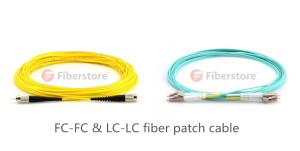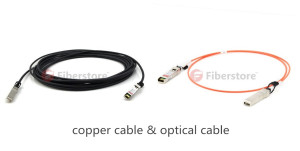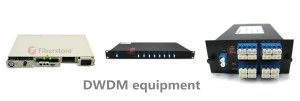-
Signals travel through fibers over large distances with attenuation. Then the optical amplifiers are needed in the CWDM (corse wavelength divsion multiplexing) and DWDM (dense wavelength divsion multiplexing). Optical amplifiers are devices that can amplify optical signals directly without the need to convert them to electrical signals. EDFA (erbium doped fibre amplifier) is the most common optical amplifiers.
Introduction of EDFA
EDFA is doped with element erbium and with the core of a silica fiber. It is one of DWDM equipment that amplifies optical fiber signals as signals will be attenuated when the transmission distance is over hundreds kilometers. The term "doping" refers to the process of using chemical elements to facilitate results through the manipulation of electrons. It is employed in the telecommunications field and in various types of research fields.Principles of EDFA
In general, EDFA works on the principle of stimulating the emission of photons. Pump lasers, known as pumping bands, insert dopants into the silica fiber, resulting in a gain, or amplification. EDFA amplification occuring as the pump laser excites the erbium ions, which then reach a higher energy level. The excited ions make transition to the ground state either by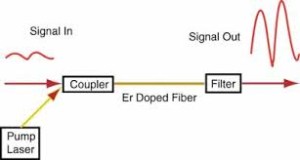 amplified spontaneous emission or stimulated emission. The amplified spontaneous emission is a major source of noise in the system. And the stimulated emission could amplify signals by generating photons. With EDFA, an erbium-doped optical fiber at the core is pumped with light from laser diodes. This type of setup in telecom systems can help with fiber communications.
amplified spontaneous emission or stimulated emission. The amplified spontaneous emission is a major source of noise in the system. And the stimulated emission could amplify signals by generating photons. With EDFA, an erbium-doped optical fiber at the core is pumped with light from laser diodes. This type of setup in telecom systems can help with fiber communications.Advantages of EDFA
EDFA has many advantages. First, it can provide in-line amplification of a signal without the need for E-O and O-E conversions. Second, it can directly and simutaneously amplify a wide wavelength band (>80nm) in the 1550nm region with a relatively flat gain. Third, it provides high power transfer efficiency from pump to signal power. At last, EDFA has low noise, which is suitable for long haul applications.Although EDFA has so many advantages, it has disadvantages as well. For example, EDFA is usually limited to no more than 10 spans covering a maximum distance of approximately 800 kilometers (km). When the distance is longer, an intermediate line repeater to retime and reshape the signal and filter accumulated noise from various light dispersion forms in the optical fiber would be required. So EDFA still needs to be improved.
 1 commentaire
1 commentaire
-
Since the invention of optical fibers in the early 1970s, the use of and demand for optical fiber today are quite numerous. With the explosion of information traffic due to the Internet, electronic commerce, computer networks, multimedia, voice, data, and video, the need for large amount of signal transmission is paramount. Fiber optics has proven to be the best solution. Single-mode fiber is one of optical fibers which is designed for the transmission of a single ray or mode of light as a carrier and is used for long-distance signal transmission.
A typical single-mode fiber has four parts: the core, cladding, buffer and jacket. In the center, it’s called the core where the light is “guided” down in the fiber. The core is surrounded by an optical material called the “cladding” that traps the light in the core using an optical technique called “total internal reflection”. The core and cladding are usually made of ultra-pure glass. The fiber is coated with a protective plastic covering called the “primary buffer coating” that protects it from moisture and other damage. More protection is provided by the cable which has the fibers and strength members inside an outer covering called a “jacket”.
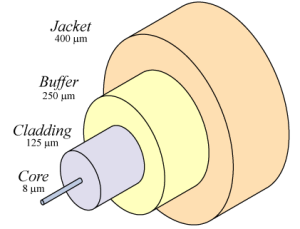
Single-mode fiber has characteristics of low dispersion, high frequency and high bandwidth. First, the high dispersion rate will make the signal worse during its transmission over long distances. When the light travels through the core, the core doesn’t retain all of the light. As a result, the dispersion will be caused when some of the light travels along the fiber cladding. Single-mode fiber could erase the dispersion. Second, the frequency at which the fiber optic signal will be transmitted can influence the signal transmission distance. The higher the frequency, the greater distance the system will be able to support. Single-mode systems have 1300 and 1550 nanometers. Third, bandwidth of fiber is described in MHz per kilometer. Typical fiber bandwidth of single-mode fiber has an inherently higher bandwidth and can reach thousands of MHz per km.Due to the special favorable characteristics of single-mode fiber, it could transmit data with high speed over long distances. And it’s usually used for connections over large areas, such as college campuses and cable television networks. So that’s why single-mode fiber is attractive especially for long distance signal transmission.
 votre commentaire
votre commentaire
-
Fiber optic patch cords are also known as "fiber optic jumper" or "fiber optic patch cables". It's commonly used in fiber optic network. According to the transmission medium, it can be divided into two types: single-mode fiber optic patch cords and multi-mode fiber optic patch cords. According to optical connector, it can be classified into many types, such as FC, LC, MU, SC, ST, etc.
This article will introduce the categories classified by optical connector to help you know more about them and choose what kind of fiber optic patch cords you need. An optical fiber connector enables quicker connection and disconnection than splicing by terminating the end of an optical fiber. Here are some popular fiber optic patch cords terminated with FC/LC/MU/SC/ST connectors on both ends.
FC Fiber Optic Patch Cords
FC fiber optic patch cords, for example, FC-FC multi-mode fiber patch cable, are with FC fiber optic connectors, which is a metal threaded screw type connection. FC connectors' floating ferrule provides good mechanical isolation. FC connectors need to be mated more carefully than the push-pull types due to the need to align the key, and due to the risk of scratching the fiber end face while inserting the ferrule into the jack.LC Fiber Optic Patch Cords
LC is short from "Lucent Connector". LC fiber patch cord connector is a push and latch structure, with plastic housing and accurate 1.25mm ceramic ferrule. LC type is a popular kind of small form fiber optic patch cord which reduces the space and it is widely used for densely installation, such as LC-LC Fiber Patch leads.MU Fiber Optic Patch Cords
MU fiber optic patch cord is also the invention of NTT in Japan. MU is a small size fiber optic patch cord with plastic housing and a push pull structure. MU fiber optic connector is similar size of LC. It's designed for high-density connections and provides more than double the packaging density of the SC connector.SC Fiber Optic Patch Cords
SC fiber optic patch cord was invented by the Japanese company NTT. It's one of the most widely used fiber optic patch cords because it has advantages of low cost, simplicity and durability. SC fiber optic patch cords are with a locking tab on the cable termination. It is a push and pull type fiber optic connector with excellent packing density.ST Fiber Optic Patch Cords
ST fiber optic patch cords are with straight tip type terminations. There is only simplex ST fiber optic patch cords and no duplex ones. ST fiber optic connectors, widely used for multi-mode networks, are usually with a metal housing, although there is plastic housing. votre commentaire
votre commentaire
-
People find it’s very difficult to discover the perfect solution for cabling infrastructure. The one is that it should depend on many complex circumstances. The other is because people don’t know very well about the properties of copper cables and optical cables. Copper wires transmit electrical currents, while optical technology uses pulses of light to carry data along strands of glass or plastic. Each one has its advantages.
Firstly, the advantages of optical cable show in these fields, bandwidth, distance and speed, safety. Optical cable has a higher bandwidth than copper and has standardized performance up to 10 Gbps and beyond. More bandwidth means it can carry more information with greater fidelity than copper wire. Because the fiber optic signal is made of light, so data can transmit at a higher speed over longer distance with less signal loss. There is no electrical current that flows through optical cable. While copper carries a current and could cause a fire concern especially when it is old or worn.
Secondly, the advantages of copper cable obviously show in the fields like power, cost, and flexibility. The copper cable could continue work if the electricity goes out because it has an emergency power supply. It’s able to power phones, surveillance cameras, Wireless Access Points, and many other devices through the networking cable itself. That’s to say an electrician is no need to be employed to power the surveillance cameras. It can also keep up with the networks by some sophisticated products, like the electronics getting signals on and off the cabling. Electrical power transmission over copper is cheaper than laser power transmission over fiber. So the copper cable is less expensive than optical cable. When you install cables in your house, you have to bend them because there are many corners. So the copper cable is very desirable as it’s flexible. It will not crack or break when you bend it.
For example, two kinds of SFP+ cables will make you know them more clearly and they are SFP+ passive copper twinax cables and SFP+active optical cables.
SFP+ passive copper cables are suitable for very short distances. They provide a low cost, low power and low latency interconnect solution for 10-Gigabit Ethernet, Fiber Channel and other industry standards. SFP+ active optical cables support longer distances than SFP+ passive copper cables. They are designed for high speed and short range data link. SFP+ AOC cable is a cost effective solution for Data Center/ storage and all short range data application.
With the same length and both compatible with the brands like Cisco, cisco passive twinax 5m is much cheaper than cisco Active Optical Cable 5m. And it requires no direct power to operate. However, active optical cable can provide high speed transmission over longer distances.
Now since you know the basic points about copper cable and optic cable, you can find a perfect solution for your cabling infrastructure.
 votre commentaire
votre commentaire
-
In 1980s, the first generation called wideband WDM (wavelength division multiplexing) using two widely spaced wavelengths in the 1310nm and 1550nm appeared. In early 1990s, the second generation narrowband WDM with two to eight channels was used. But people would never be satisfied with network transmission rate. They want to see videos or watch movies which require a large amount of bandwidth capacity. Because of these consumers’ demands for bandwidth, by the mid-1990s, DWDM (dense wavelength division multiplexing), the new generation of optical fiber communication technology emerged. DWDM is a technology that puts data from different sources together on a single optical fiber, with each signal carried simultaneously on its own separate light wavelength.
Advantages
After DWDM came into the world, it lays the foundation for the traditional electronic networking developing into optical networking. It makes optical fiber fully applied and brings many advantages to human beings.
- Large fiber capacity
- Improved scalability
- Compatible all-optical exchange
- High reliability and flexibility of networking
- Fewer fibers to transmit and receive data
- High optical signal transmission speed
- Lower attenuation and dispersion
- Low cost for no need of OTU
- Able to carry different types of traffic at different speeds over an optical channel because its protocol- and bit-rate are independent
Applications
Since DWDM has so many advantages, DWDM were widely applied in transport networks and analog video transport networks (such as hybrid fiber/coax CATV/data networks). It’s also used in various specific networks, for example, sensor networks, remote radar networks, and telespectroscopic process control networks. And DWDM is still popular in photonic technologies because it supports more bandwidth at low cost and it can protect and reconfigure the large networks well.
DWDM Equipment
At present there are some related DWDM equipment and they are optical amplifier, optical add-drop multiplexer (OADM), optical cross connect (OXC), multiplexer/demultiplexer (MUX/DEMUX) modules, DWDM Transceivers, etc.
- Optical Amplifier
An optical amplifier is a device that amplifies an optical signal directly, without the need to first convert it to an electrical signal. An optical amplifier may be thought of as a laser without an optical cavity, or one in which feedback from the cavity is suppressed. Optical amplifiers are important in optical communication and laser physics. Now Erbium Doped Fiber Amplifier (EDFA) is the most common type and used as a building block in DWDM system. It can efficiently amplify light in the 1.5μm wavelength region where telecom fibers can’t reach. It could provide about 40-50nm of bandwidth and gain spectrum.
- Optical Add-Drop Multiplexers
Optical add-drop multiplexers are used to add and drop wavelength channels from a DWDM multi-channel stream. In other words, they are designed for wavelength division in DWDM system. The main function is to couple two or more wavelengths into a fiber.
- Optical Cross-Connect
An optical cross-connect (OXC) is a device to switch high-speed optical signals in a fiber optic network, such as an optical mesh network. By connecting it with DWDM, wavelength switching and wavelength conversion happen. It meets the requirement that the wavelength routing can be reconfigured but still maintains its transparent nature in DWDM networks.
 votre commentaire
votre commentaire
